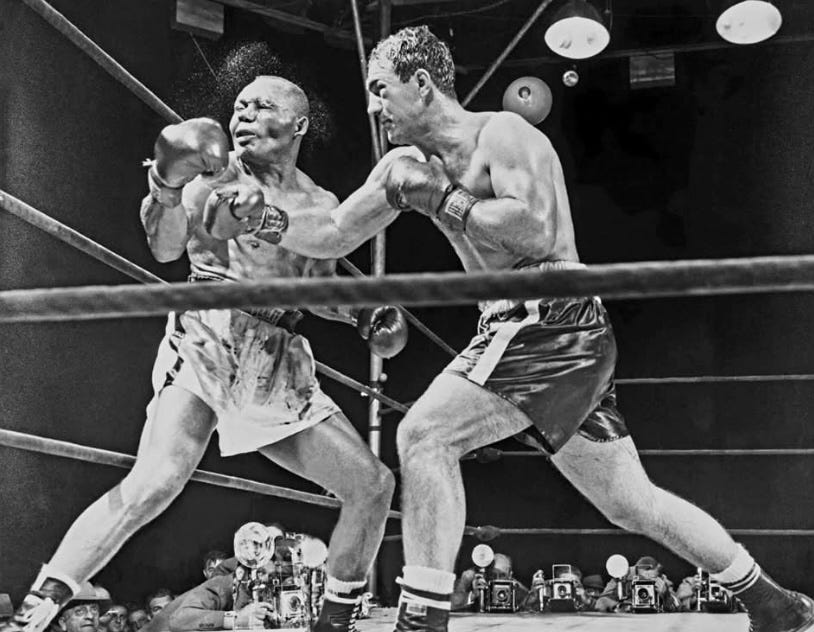I stand corrected. Or maybe adjusted. Whenever I would attempt to show a black and white film in the classroom, be it Muhammad Ali vs. Sonny Liston II or The Marx Brothers or Laurel & Hardy or even The Three Stooges, as soon as the picture would appear on the screen, there would be a collective groan.
“Black and white? I can’t watch a black and white movie.”
Of course, I would chastise them, “Some of the greatest movies of all-time were made in black & white. Get over it.” And generally speaking, they would get into it and enjoy the show.
(I mean, they’re WATCHING something in an English class? GET A GRIP!)
But lately, in my relaxing moments late in the evening flipping through YouTube, I came upon a staggering series of old-time prize fights, most of which I’ve seen before, that are revitalized. How? They are COLORIZED. And yes, folks, it does make a difference.

Look at the difference between the two photos! One of the greatest action shots ever.
As you can see, comparing the two photos of poor Jersey Joe Walcott being on the receiving end of one of Rocky Marciano’s ol’ Susie Q’s, the color shot is just that much more dramatic, arresting, stunning. This colorization is one of a bunch of them found on the site Legends Of Boxing In Color on YouTube.
According to what I found online: “Black and white movies are colorized using a combination of digital techniques, including AI-powered software and manual adjustments by artists. The process involves scanning the film into a digital format, then analyzing each frame to identify objects and predict colors based on historical data and reference images. Artists may also manually adjust colors to ensure accuracy and artistic consistency.”
Oh. AI again, huh? Well, the Marciano-Walcott I fight was one of the most hotly contested in heavyweight history, as A.J. Liebling’s stirring account in his classic “The Sweet Science” suggested, the two fighters taking turns leading on the judge’s scorecards. Marciano, likely trailing on all three cards, finally caught up with Walcott on the ropes in the 13th round and landed an absolutely stunning right hand that send Walcott to dreamland.
They actually had a rematch which was one of the most disappointing heavyweight bouts ever. Marciano caught Walcott with a right uppercut after a very tentative (read: boring) in the first round. Walcott sat quietly, listening to the referee count him out, then stood up after he reached “10” which meant the fight was over.
Liebling wrote an absolutely delightful account of that fight for The New Yorker, “Long Toddle, Short Fight” that I would use in the classroom, showing my Journalism students the lousy fight, then Liebling’s terrific story, demonstrating that you can still write a great piece about a rotten event. If you’re a boxing fan, I highly recommend “The Sweet Science” if you haven’t read it yet. My favorite!
There are quite a few terrific fights on the Legends Of Boxing In Color website available on YouTube. The quality of the colorization varies, of course, but to my surprise, it does add to the drama, the excitement, the “color” of the event.
The other night, I watched the Jersey Joe Walcott vs. Ezzard Charles match, their third fight against one another and it made me think about how, in those days, boxers, particularly good ones, would fight one another multiple times. Sugar Ray Robinson and Jake LaMotta, for example, were each so good in their respective classes that nobody wanted to fight them. So, they fought each other six times, LaMotta winning the first fight, Robinson winning the rest.
“I fought Sugar Ray so many times, it’s a wonder I didn’t get diabetes,” LaMotta said.
ROCKY’S CLASSIC FIGHT vs. ARCHIE MOORE, HIS FINAL FIGHT IN COLOR




I agree about the old fight films done over with color, ( as long as It’s well done and not a garish cartoon of they started with, the tools are at a point now where a very good match up of color can be achieved!) As far as classic films are concerned, a reasoned considered consideration is needed. I have seen a colorized clip from one of the music scenes from “Yankee Doodle Dandy” and it looked great, ( & I Love that movie) . However I saw the same treatment to a clip of “Casablanca” ( I also Love this movie) and it was terrible. Because of the utterly dark nature of the times being portrayed it was purposely filmed in B/W even though the budget allowed for technicolor film,…… Colorizing it was a mistake. My two cents :)